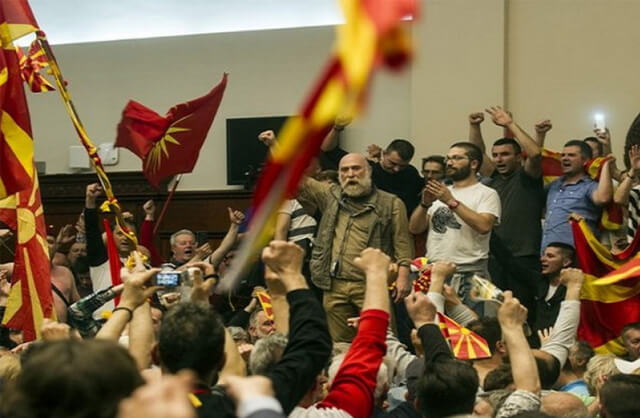Special report on identified and possible crimes committed during the violent attack on the Assembly on 27 april 2017

Immediately after the election of the new President of the Assembly of RM by the parliamentary majority, on 17 April 2017, around 19:00, the organizers and participants of the protest group known as “For a United Macedonia” forcibly entered the parliament building. According to the numerous video recordings, police officers in charge of keeping the public order and safety of the participants in the parliamentary halls allowed the protesters to enter the building unhindered. Persons who were wearing face masks and carried hard and sharp objects intended to endanger the physical integrity of those present in the Assembly were allowed to enter as well. Shortly afterward, around ten MPs were injured (of which at least one suffered severe injuries) as well as journalists, citizens over 70 and over 20 police officers. The Ministry of Interior in coordination with the Public Prosecutor’s Office Skopje identified around twenty perpetrators of crimes. Some of them have been taken for questioning, while others were placed in detention, house arrest or faced other precautionary measures. For the time being, the identified perpetrators are suspected of committing three types of crimes: participation in a crowd which prevents an official person from performing an official action, participation in a crowd which commits a crime and causing a general danger.
This special report covers the committed crimes identified through photos, audio-visual recordings, and testimonies as well as the suspected crimes for which it has not been yet investigated whether they have been actually committed or by whom. The report addresses the violations of rights and freedoms guaranteed by the Constitution and sanctioned under the Criminal Code. The report aims to inform the public, but also to serve as a useful tool for judicial authorities in making decisions related to the identification of crimes and individualization of criminal responsibility in the process of imposition of fines by the court. It contains a total of 27 crimes, 17 of which are already provable with considerable evidence, and 10 suspected crimes. The possible perpetrators are divided into four groups: 1) organizers, 2) perpetrators, 3) police officers and 4) their superiors. The crimes are established as such in 8 chapters of the Criminal Code, and were directed against: 1) the life and body, 2) the freedoms and rights of citizens, 3) property, 4) security, 5) State, 6) office, 7) judiciary and 8) public order. The role of the judicial authorities is to determine whether and which of the said crimes have been committed or if there was an attempt to commit those crimes as well as to prevent erroneous determination, joint accountability and arbitrary sanctions.



